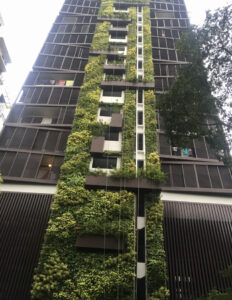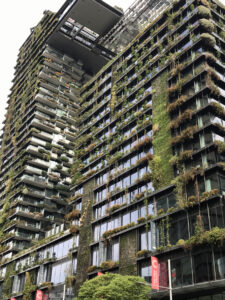
Successful plant selection for green infrastructure installations
By Michael Casey
With urbanisation spreading from the cities into our peri urban environments, we are sure of one thing, our built environments are going to lead to more problems that will affect the ways in which people comfortably live their lives.
According to the United Nations Sustainable Development Goals, our cities currently occupy only 3% of the earth’s land but account for 60-80% of energy consumption and 75% of carbon emissions. This is also on the back of our cities currently being home to half of humanity, or 3.5 billion people. with this number expected to rise to 5 billion or 60% by 2030.
Rethinking the role that our cities play in our future is an area being examined by many experts around the world, and specially, this article will explore the specific features and functions around incorporating more nature-based solutions into the grey environment. The use of many green infrastructure solutions, outside of building and engineering specifics, requires an in-depth knowledge of plants and how to ensure they thrive in these foreign environments.

Currently, some of the major environmental problems encountered in our cities relate to urban heat, a lack of vegetation and biodiversity, and increased wastewater discharge, to name a few. Solutions do exist to address these challenges, however they require a level of expertise that can only be sought from professionals who have been trained in, and have experience in, fields associated with green infrastructure, planning and design.
Building green roofs, rain gardens, swales, and naturalising water ways, are proven ways to assist in wastewater management. Green walls, built gardens and landscapes, and the introduction of trees and urban forests, will also assist with water management, biodiversity and cooling of cities.. The plant selection is critical, along with the management of them, to ensure that intended outcomes are realised.
Firstly, there are many complexities surrounding planting into urban environments, both on buildings and at ground level. The one basic principle we derive from basic horticulture is to provide a sound planting zone with adequate room, and a balance between available nutrients, air, and water to ensure plants will grow regardless of the environmental conditions.
We can appreciate that urban environments present challenges related to providing adequate substrate volume as available space is always limited. At ground level, we compete with utilities in the ground, impermeable surfaces and preinstalled infrastructure. Building weight loading is a complex challenge along with the cost of either retro-fitting buildings to accommodate the extra weight, or allocating extra funding to a building project to incorporate plants.
To address a healthy canopy coverage, the specifying of a suitable soil depth and overall volume is required for deep rooting of the plants and trees to ensure adequate canopy growth. The smaller the volume, the less canopy cover, biomass growth and specific leaf area. Ensuring this planting volume is correct at planning stages will ensure future growth success and lead to correctly specifying weights on buildings or spaces available in the ground, along with fit-for-purpose plant choice. Understanding plant growth habits and their ability to grow in these confined spaces will also assist in specifying a suitable variety. The research that’s been undertaken on plant suitability for urban environments is accessible and is extensive, so serves as a beneficial resource to ensure plant selection and soil volumes can be addressed when forming a plant selection criterion.
The availability of water for plants and trees will be a topical area that requires early discussions during the planning phases. This will include forming an understanding of what type of available water can be used and the methods to be applied for irrigating the gardens. Urban installations can become too reliant on potable water when there are many other suitable alternatives. Potable water can be made available but is often more expensive if not managed well, especially if a backup source is not available. Problems can arise with water sources via the poor labelling of pipes, a lack of information about irrigation set up, allowing pipes and systems to be accessible by/to others which can result in serious decline in plant health or death, along with compromised or inadequate amounts of water being delivered to the gardens.
Similarly, roofs and walls of buildings that are to be planted out will also require thorough planning to ensure water can be made available, and prior to the installation commencing. This can be made more difficult when we address the retro-fitting of interior spaces that may not have any access to water points. Water is an extremely important factor when considering plant selections and more importantly, sustaining healthy growth.
Non-portable sources, such as rainwater can be successful. This might be capturing rainwater via the top or underneath the buildings, and used in closed-loop irrigation installations for green roofs and walls, or even having rainwater diverted into specialised garden beds such as tree pits, permeable paving installations or rain gardens. Capturing non-portable water should be used as an asset but is often overlooked as waste, and piped away to creeks and rivers to quickly remove it from the built environment.

There are challenges when considering water options and ensuring healthy plant growth, and that comes with understanding the varying qualities of water and what plants can and cannot endure. Curb and channel collection of water, distributed to rain gardens and tree pits, is a great way to utilise this asset but ensuring gardens are set up correctly, and appropriate plants selected, is paramount to address times of heavy water inundation along with a vast array of pollutants entering the growing media. Captured rainwater for use in green walls and gardens can also be advantageous for those who are able to collect it, however it can be unreliable in its availability therefore back-up measures will be required. Even the use of captured rainwater can have quality fluctuations and depending on where the water was sourced from, the quality of the water still needs to be monitored before it makes its way to the plants and trees. Where a closed loop irrigation system is concerned, this can be utilised, however it also poses the question of management of the pH and EC levels to ensure plants can withstand these fluctuating levels.
Lastly, but not least, lighting conditions and the available quality of light is a factor. Built environments are made up of buildings of varying heights, shapes and materials, and all play a significant part in governing light quality and quantity to your garden. The change of seasons and changing angle of the sun all contribute to seasonal light fluctuations that will need to be factored in. How will new tree installations affect lower plantings or adjacent green infrastructure installations like green walls and roofs? What about new garden installations that had available light at the time of installation but with months or years passing, a new building is erected adjacent to their location which then limits the available light levels?
Seen mostly in urban settings, the reflective light levels from other buildings can also cause damage to plants. A new installation may be devoid of direct sunlight but at certain times of the day, has severe reflection from an adjacent building. The flowering of plants will be an issue in some areas of the urban environment. Clients may be seeking flowers and colour, only to be disappointed when the lack of sunlight hours to the plant affects the flowering quality or ability for the plant to produce any at all. Urban farming, which is encouraged in urban environments, may only be truly successful in dense, built environments if they are installed on roof spaces that are exposed to adequate light.
Professionals will need to continue to promote the use of greenery in our built environments and this is going to require a thorough knowledge of plants, along with planning, to provide these environments with the best possible growing conditions. The three components mentioned above relate specifically to the implications in providing a suitable growing environment but the proof is all in the planning.
Michael Casey MAIH RH 106
Director of Evergreen Infrastructure and
MJC Horticulture
E: michael@evergreeninfrastructure.com.au
Main photo: Parkroyal extensive gardens (Image: Michael Casey)
